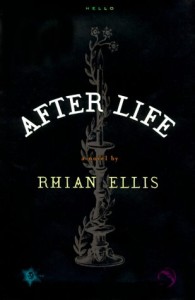 After Life—Rhian Ellis–2000-available
After Life—Rhian Ellis–2000-available
“First I had to get the body into the boat. This was more than ten years ago, and I’ve forgotten some of what came before and after, but that night and the following day I remember in extravagant detail.”
I was hooked immediately from those first lines. I read and read, and read some more, long into the night, on a wicker chair, covered in vintage barkcloth in the corner of what I had recently created and called, ‘the library’. I finally finished as dawn arrived, deeply moved and satisfied that I’d just read a fascinating and gloriously good book. A few years later I did the unthinkable for me, I reread a book–this one, and was moved and satisfied again. After Life is extraordinary. The crime exists, but it’s not the focus of the story. Questions on life, death, and yes, after life play in the background. Naomi’s story could be anyone’s, the basic crime committed could have happened to me. What turns a simple crime into a deeply resonating story is the magnificent prose and language used within. Ann Patchett expresses this way:
“After Life is that rarest of wonders, a book that is both exquisitely written and a thrill to read.”
The protagonist grew up in the shadow of a larger than life mother whose belief in her own powers of spiritualism touched all parts of Naomi’s own psyche. They lived in New Orleans with Naomi’s grandparents. When her grandmother died suddenly, her mother reacted as if her mother, Dora, was right beside her in everything she did, such as cleaning the house.
“–and now my mother was chatting with her as if nothing had happened, as if my grandmother had simply misplaced her body but might find it again at any time, under a sofa cushion or in the back of the fridge. Until that moment spiritualism had been a fun sort of game to me but suddenly the momentousness of it unfolded darkly in front of me: it could allow you to raise the dead.”
Her mother practiced an outdated type of clairvoyance–complete with trumpets and knocking taps on tables. In the 1970s, no one used those things–they were psychics, or mind readers, not the type Houdini tried to put out of business all those years ago. Yet, when her mother became too popular the police suspected other things were going on than chatting with dead. Mother and daughter left the grandfather behind and moved to Train Line, a town just for spiritualists in the very western tip of New York state.
Patterned on the real town of Lily Dale, Ms. Ellis describes the setting with an eye to detail, and then allows her writer’s inspiration to take it to its own place. I visited Lily Dale after reading and rereading, and understood the character of the town, realizing that Train Line was not a photograph, but more of a watercolor depiction of a mystical place on one hand, and a brutally cold and somewhat alien place for the young, and then older Naomi.
“Peter stayed buried for ten years” begins chapter three. And thus the unraveling of Naomi’s darkened secret begins.
I wish I could convey the beauty of Ms. Ellis’ writing. Even while perusing the book once more for this synopsis, I was taken with how delicate the writing was, how subtle its power to pull the reader into Naomi’s world. How one aches for Naomi’s mistakes and turmoil, wishing as she most probably did, that she could time travel back to the mili-second tragedy struck.
I was captured by this true soulful thought about Peter, Naomi’s dead love.
“If he had lived, I would have stopped loving him. I am so sorry.”
